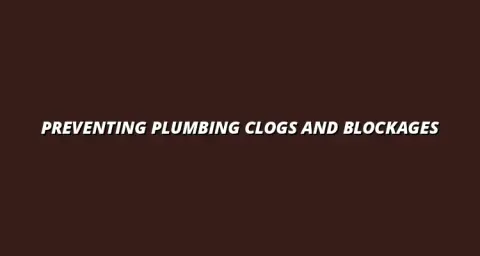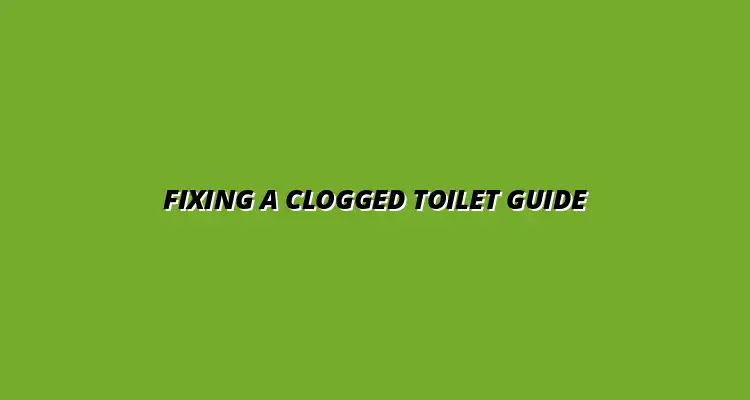
- Plumbing Basics
- Feb 14
2025-01-03
Dealing with a clogged toilet can be super frustrating! Understanding the causes behind these blockages is the first step in effectively fixing the issue. By knowing what can lead to clogs, you can take steps to prevent them in the future!
Let’s explore some of the most common reasons why toilets get clogged. By recognizing these factors, you can be better prepared to handle any plumbing emergencies that may arise.
Toilets can become clogged for various reasons, and knowing them can save you a lot of trouble. Here are some of the most common causes:
Using too much toilet paper is a frequent culprit behind clogs. It can easily create a mass that the toilet can’t handle, especially if the plumbing is older or narrower. To keep things flowing smoothly, try using less toilet paper or consider flushing more than once if needed!
Remember, using thick or quilted toilet paper can also contribute to this problem. You might want to switch to a thinner option if clogs happen often.
Sometimes, kids (or even adults!) may accidentally drop foreign objects into the toilet. Toys, personal items, or even cleaning supplies can block the drain. If you suspect something other than waste is causing the clog, it’s essential to address it quickly!
You can try to remove these items manually or with tools, but don’t force anything that’s stuck too deep. This could lead to more damage!
Flushing items that aren't meant to go down the toilet is a huge mistake that many make. Things like wet wipes, feminine hygiene products, and paper towels can lead to serious clogs. Make sure to only flush human waste and toilet paper to keep your pipes clear. For more tips on keeping your bathroom drains clear, check out this helpful guide on how to unclog your bathroom drain easily.
Sometimes, clogs are just a symptom of a larger problem within your plumbing system. Old pipes, tree roots, or buildup of minerals can all contribute to slower drainage and frequent clogs. If you notice persistent issues, it may be time to call in a professional to investigate. Understanding plumbing traps can also help you understand potential clog sources.
Regular maintenance can help identify potential plumbing issues before they become major problems. Stay proactive about your home's plumbing health!
When you face a clogged toilet, having the right tools can make all the difference. With a few essential items, you can tackle the issue effectively and confidently. Let’s take a look at the must-have tools and materials to keep on hand for unclogging toilets.
Being prepared allows you to act quickly and efficiently when a clog strikes, saving you from unnecessary stress!
Here are some basic tools that are incredibly helpful when it comes to removing clogs:
A plunger is your best friend when it comes to unclogging toilets! It creates a vacuum that can push the clog through the pipes. Always have a good-quality plunger ready in your bathroom!
Remember to use a flange plunger, which is specifically designed for toilets. This will give you better results than a standard cup plunger.
For tougher clogs, a toilet auger is a fantastic tool to have. It can reach deep into the toilet's trap and break up clogs that a plunger can't handle. Knowing how to use it properly can give you extra power when tackling stubborn blockages!
Make sure to follow the instructions carefully to avoid damaging your toilet.
Having a bucket and towels on hand is essential for cleanup after a clog. If things get messy, you’ll want to have something to contain any overflow. Plus, towels can help wipe down any spills, ensuring your bathroom stays tidy.
It’s always better to be prepared — nobody wants to deal with a bigger mess during an already stressful situation!
In addition to tools, having the right cleaning supplies is crucial for keeping your toilet in good working order. Here’s what you should consider:
Before you tackle any plumbing issue, make sure to wear gloves and safety gear. This helps protect you from bacteria and harsh chemicals. It's a small step that can make a big difference in your safety!
Investing in a good pair of rubber gloves can go a long way. They ensure you’re ready for any dirty work!
Using drain cleaning solutions can help with maintenance and minor clogs, but be sure to choose products that are safe for your plumbing. Alternatively, you can try unclogging your drain naturally with household items. Always follow the instructions on the label!
Regularly using these cleaning solutions can help keep your toilet running smoothly and prevent future clogs.
Clogged toilets can lead to a lot of confusion and stress, especially when you’re not sure how to handle the situation. It’s important to know what steps to take to minimize damage and resolve the problem quickly. In this section, I will answer some common questions about clogged toilets to help you feel more prepared!
Whenever you face a toilet issue, it helps to have a plan. Let’s dive into some frequently asked questions that many homeowners have when dealing with clogs.
If your toilet overflows, the first thing you need to do is to stop the flow of water! Quickly turn off the toilet’s water supply by locating the shut-off valve, usually found behind the toilet. Once that’s done, take a moment to clean up the mess and avoid any water damage.
After dealing with the overflow, you can assess the situation. Here are some steps to follow:
Many people swear by using baking soda and vinegar as a natural remedy for minor clogs. This combination can help break down some materials without harsh chemicals, making it a safer option for your plumbing system. However, it’s best used for smaller clogs rather than severe blockages.
Here’s how to use this method:
Maintaining a smoothly functioning toilet is essential for any home. Knowing when to tackle a clog yourself and when to call for help is key! Proper action can save you time, money, and headaches in the long run. If you're dealing with a running toilet, learning how to fix a running toilet easily can save you water and money.
Every homeowner should be informed about the potential issues that can arise with their plumbing and take preventive measures seriously. Let’s explore some concluding thoughts to aid you in your journey.
Sometimes, despite our best efforts, a clog may be too stubborn or complicated to handle alone. In such cases, it’s crucial to evaluate your situation and determine if a professional plumber is needed. Here are some signs that indicate it might be time to call in an expert:
Replacing a toilet flapper is a relatively simple DIY task that can resolve many toilet issues. Learn how to replace a toilet flapper easily in our guide. If you have more complex kitchen plumbing issues, you may find our article on fixing a clogged kitchen sink helpful.
Taking prompt action when you encounter a clogged toilet can make all the difference. The longer you wait, the more severe the problem may become, leading to costly repairs! By being proactive and addressing issues quickly, you can maintain the health of your plumbing system.
Remember, a well-maintained toilet not only ensures comfort but also protects your home from potential water damage. Stay informed and tackle small problems before they escalate!
